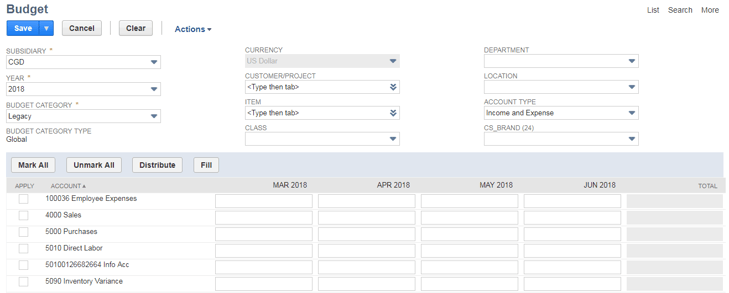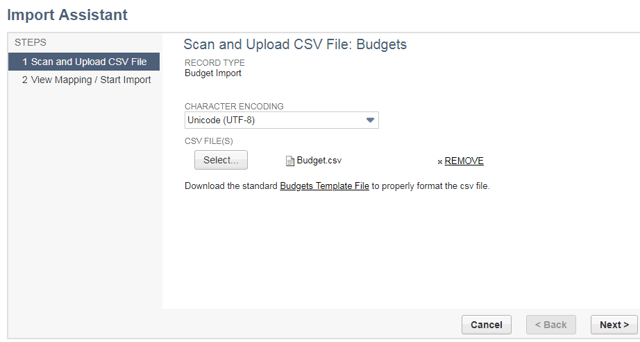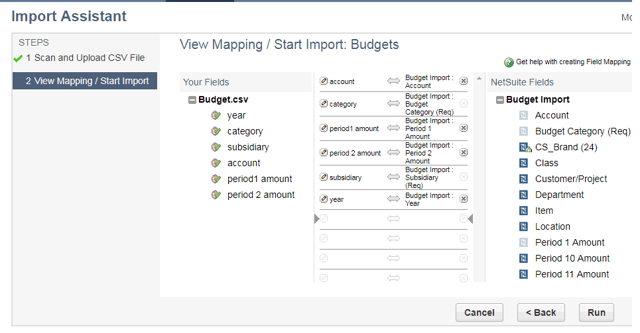It provides estimation of expenses for a specific period of time, and can help provide visibility for financial planning. Users ability to select and define accounts that are needed for their budgets and provide expense and income statements over a set period of time. It’s easy to set up a new budget in NetSuite, or import a budget that you have externally. You can also enter budgets in statistical accounts and also create budgets for departments, classes, locations, items, and customers or projects.
Steps for the process of working with budgets:
1. Entering a Budget:- Go to > Transactions > Financial > Set up Budgets
- If you use netsuite one world account select subsidiary.
- Choose the Budget Year and Budget Category.
- Complete the other fields with the necessary information.
Adding New Budget Category:
- If the Budget Category is not available in the selection, you can add a new one.
- Step 1: Navigate to the Budget page.
- Step 2: In the Budget Category field, select New to add a new category.
- In the Account Type field, you can filter the types of accounts for which you are creating this budget.
- Income and Expense - accounts included in both income and expense sections of Income Statement reports.
- Income - accounts included in income sections of Income Statement reports.
- Expense - accounts included in expense sections of Income Statement reports.
- Balance Sheet - accounts included in Balance Sheet reports, assets, liabilities, and equities.
- All - accounts included in Income Statement, Balance Sheet reports, and statistical accounts.

Filling out the Budget:
- Here, you can identify the dollar amount per month of your budget. You can apply a check mark by a specific account for that month and can enter the amount individually per month, or by copying the amount from the first month to all remaining months.
- To do this, enter an amount in January, select the account that you want to apply it to, and select the “Fill” button. This will fill your budget in for you. You can also evenly distribute amounts in your budget.
- This is done by selecting the “Apply” box next to an account, entering an amount in the first month, and selecting “Distribute.” Once you have completed filling in this part of your budget, hit “Save.”

Once you have finished creating or importing your budget, you can review the Budget Income Statement by going to Reports > Banking/Budgeting > Budget Income Statement.
Editing an Existing Budget :
- Go to Transactions > Financial > Set Up Budgets > List.
- Click the Edit link next to the budget you want to modify.
- Modify the fields and each budget record as required.
- To delete this budget, in the Actions menu, click Delete. Click OK to confirm the deletion.
- Click Save.
You can save time when creating a budget by copying a previous year's budget or by having NetSuite create your budget based on last year's actuals.
There are two types of copying a budgets i.e.,
- Copying a Previous year Budget.
- Budget on a Previous Year's Actuals
Copying a Previous year Budget:
- The Copy Budget feature creates a new budget record by copying a budget from different year.
- If the Accounting Periods feature is not enabled, you can create a new budget by copying a budget from any year.
- Suppose, if you are replacing the budget, the existing budget is deleted before the process copies the new budget.
- Go to Transactions > Financial > Copy Budgets.

For Example,
|
Account |
year |
Amount |
|
Income Account A |
2016 |
12000 |
|
Income Account A |
2017 |
24000 |
- Copying Budget from all years to 2018 (Modify by = 10 %, Replace = False).
|
Account |
year |
Amount |
|
Income Account A |
2016 |
36000 = (12000 +24000) + 10% |
Budget on a Previous Year's Actuals:
- When you create a new budget based on the actuals from a previous fiscal year, the process copies the values associated with the specified account types and budget categories to the new budget.
- Suppose, if you are replacing the budget, the existing budget is deleted before the process copies the new budget.

Step 1: Navigating to the Import Page
- To get to the budget import page, simply go to Transactions > Financial > Set Up Budgets > Import.
- You will have to select the character encoding (Unicode UTF-8) for your spreadsheet, and upload your CSV file into the system. Once you have done this, click on the “Next” button.
- If you need help formatting your budget into a file that can be imported, you can select the Budgets Template File link to download a template for your file.

Step 2: Mapping Your File Import Fields
To ensure your data imports correctly, you will want to map the following fields: Subsidiary, Account, Budget Category, Customer/project, Year, Period Amount (1 to 12) etc..

Step 3 Reviewing the Import Mappings:
Once you’ve imported your budget, you can view it at transactions>financial>setup budgets>list and choose the appropriate budget from the list
In this context, budgets are very useful to provides estimation of expenses for a specific period of time, and can help provide visibility for financial planning.



